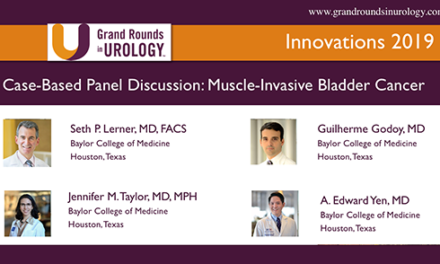Dr. Daniel P. Petrylak presented “Beyond Checkpoint Inhibition: New Therapeutic Approaches to Bladder Cancer” at the International Bladder Cancer Update meeting on Tuesday, January 24, 2017.
Keywords: bladder cancer, chemotherapy, docetaxel, MTOR, TORC1, TORC2, TSC, VEGFR
How to cite: Petrylak, Daniel P. “Beyond Checkpoint Inhibition: New Therapeutic Approaches to Bladder Cancer” January 24, 2017. Accessed Nov 2025. https://grandroundsinurology.com/beyond-checkpoint-inhibition
Transcript
Beyond Checkpoint Inhibition: New Therapeutic Approaches to Bladder Cancer
There are some patients of course who can’t receive cisplatin-based therapy, but not all patients are eligible for immune therapy. If they’ve had autoimmune diseases, if they’ve had psoriasis that requires that they go on systemic therapy, if they’ve had Guillain-Barre Syndrome, or rheumatoid arthritis. These are situations where you probably don’t want to give checkpoint inhibition therapy. So, we’re looking at different targets in bladder cancer, and one that we’ve focused on is VEGF, and we know that these agents, particularly anti-VEGFR-2 are particularly active in chemo sensitizing human bladder cancer cell lines, and VEGFR-1, which is more affected by drugs such as bevacizumab, which binds VEGFR-1, may actually inhibit metastatic disease.
We were looking at this particular different pathway, and we know that ramucirumab, which is approved for gastric cancer, will bind to VEGFR-2. And we looked at another specific inhibitor of VEGFR-1, icrucumab, and looked at a randomized trial in bladder cancer because we knew that there was synergy between these agents. And again, this is the VEGFR-2 expression in the urothelium. We tend not to see expression in the normal urothelium, but in metastatic disease we actually see fairly strong expression of VEGFR-2.
Actually, this trial actually started about five years ago, it’s hard to believe. But this is a randomized trial. We just published this in JCO looking in patients who’ve failed prior chemotherapy, randomizing them to docetaxel, docetaxel plus ram, or docetaxel plus icrucumab. And it was a randomized phase II, and our primary endpoint was progression-free survival.
So, this is the PFS slide that got us interested in continuing this further. So, as you can see here the progression free survival with docetaxel is about 10.4 months. It’s double when you add ram to that, and it’s seven months, which is actually a little bit worse when you add icrucumab to docetaxel. So, the survival, this trial was not designed to look at a survival endpoint, but the survival that we reported with the combination was 12 months, which is comparable to what we’re seeing with some of the checkpoints at this point.
This has led us to go onto an international randomized study, which is now still accruing patients. Hopefully we’ll be fully accrued within the next two months. Of docetaxel plus ram versus docetaxel we are allowing patients who have progressed on prior checkpoint inhibition therapy. They’ve had to at least received one prior chemotherapy to go on the study.
We also just completed, and I’m going to report this at ASCO GU this year, a phase I trial combining pembrolizumab plus ramucirumab, again because we think that there may be synergy between inhibiting VEGF as well as a checkpoint inhibitor, and I’m going to present the bladder cohort at ASCO GU this year.
What about other targets? What about other smart ways of going after chemotherapy? Well, this is one way which I think was underappreciated and we’re seeing a lot of really good data with this. So, this is looking at antibody drug conjugates, and this approach is approved for Hodgkin’s disease, refractory Hodgkin’s lymphoma, and what we’ve done is we’ve taken a monoclonal antibody to a particular antigen on the bladder cancer cell. This one I’ll show you is called Slitrk7. We’ve linked it through this linker technology to MMAE, which is an anti-tubule agent. Much more powerful than a taxane. In fact, if you infuse this particular drug at the levels that we achieve in cells in the patients you kill them, you basically wipe out their bone marrow. It’s an extremely toxic drug but it’s not when it’s released in the circulation. And this approach has been taken with prostate cancer and we’ve actually reported some data with the anti-PSMA antibody. This gets cleaved once it gets into the cancer cell, so this releases the MMAE, it goes to the cell, to the tubulin, and then causes a cytotoxic effect. So, this is where it’s a cytotoxic drug. It’s cleaved by cathepsin B.
This is Slitrk6, which is a membrane protein. It’s actually a neuroprotein that’s expressed in 54% at a high level of bladder cancer specimens, and 94% of all bladder cancer specimens that were looked at.
We went into a phase I trial of this conjugate. It’s the ASG-15ME complex. And we escalated from 0.25 mg/kg, we finally established the dose at 1.0 mg/kg. But this was a fairly heavily pretreated group of patients, 54 patients, 30 of those 54 had more than two prior systemic therapies, a quarter of those patients had liver metastases, and 31% had prior checkpoint therapy.
This is our plot, our waterfall plot looking at responses, and we see responses really at all dose levels. But what’s really, really impressive is when we start plotting this out based upon different responses. So, we see here that overall we start, that in the 1.0, which is the recommended phase II dose, our objective response rate is 50%. We’re seeing responses in patients who have had prior checkpoint inhibition therapy at the recommended dose, 42.9% of those patients who failed checkpoints are responding. We’ve got complete responses in liver with this particular approach as well, so this is an active drug and it’s going to be moving forward.
The phase I study is showing that the most common side effects are anemia, increased lipases, as well as urinary tract infections, and our maximal tolerated dose is 1 mg/kg. There is a similar drug which targets nectin, and the results are almost superimposable. You see the same thing, complete responses, even in visceral sites, and about a 35% response rate in those patients who’ve failed prior checkpoint therapy. So, this is now moving forward into patients who have received prior therapy as well as platinum-ineligible patients.
Dan was mentioning before about personalized medicine in bladder cancer. We’re also beginning to identify specific mutations which we can target. FGFR3 is one that occurs, and you can see that there’s a hotspot which is mutated on FGFR3, predominantly in low-grade superficial disease, but you identify this in about 10% of patients who have metastatic bladder cancer. A variety of different companies are targeting drugs at FGFR3.
One trial in particular, which I think is interesting, is the BISCAY trial, which is an umbrella trial that is basically looking at patients who have failed prior bladder cancer therapy, chemotherapy. Everybody is going to be getting durvalumab, but if you’ve got an FGFR3 mutation AZ547 is an FGFR inhibitor, that’s going to be targeted in the situation. If you’ve got a DNA repair problem a PARP inhibitor is going to be given. If you’ve got a retinal blastoma mutation or deletion a WEE1 inhibitor is going to be given. So, this is again a way of trying to increase the efficacy of targeted therapy.
Joe Kim at my institution, who is one of my junior attendings, has been focusing on the mTOR pathway, which we know is an active pathway in renal cell carcinoma. And there has been some data looking at mTOR inhibition in bladder cancer. Matt Milowski has published on this, and also Seront at Memorial Sloan Kettering Cancer Center. The response rate is not really impressive. They had two confirmed partial responses, but again the biology is leading us to try to move this forward in other patients. So, there was one index patient on Milowski’s trial who had a major response to everolimus in lymph node, and they sequenced this particular patient, and they found that she had a TSC3, TSC1 mutation, which is also on the mTOR pathway. And in fact, the responders did seem to have a TSC1 mutant in this particular trial. So, this seems to be a reasonable way to be going after mTOR inhibition, and TSC1 will be another way of attacking AKT, and this can affect cell growth, translation, and tumorigenesis. Everolimus actually hits TORC1, which is a different plot.
Looking at the TCGA database the overall frequency of TSC1 mutations is about 8 to 15% in bladder cancer, and so Joe is going to be looking at MLN-0281, which a highly selective inhibitor of mTOR kinase that will affect both TORC1 and TORC2 complexes. This will also inhibit the feedback that goes on with AKT because when you have this mTOR inhibition AKT can be upregulated to disrupt that, and this potentially has a greater clinical benefit in patients. So, this is a hypothesis, this will affect TSC1 and TSC2 in bladder cancer, and also TORC1 and TORC2 as well.
This is an NCI-approved protocol that we just opened up. We’re taking those patients. We’re sequencing pretty much every patient who comes in to Yale with bladder cancer looking for this particular mutation, and we opened this trial, it’s actually opened in several different centers on 12/2 of this year, hopefully to see if there’s more activity with this mutation.
In conclusion, checkpoint inhibition therapy demonstrates activity in cisplatin-treated urothelial carcinoma, but only about a quarter of patients. Angiogenesis is being looked at as a target, combined with chemotherapy, and then these ADC complexes have significant activity in those patients who’ve failed prior checkpoint inhibition.
ABOUT THE AUTHOR
Daniel P. Petrylak, MD, leads the genitourinary cancers medical oncology team at Smilow Cancer Hospital as director of the genitourinary cancer research group, professor, and co-director of the Cancer Signaling Network program. Dr. Petrylak joined Yale from Herbert Irving Cancer Center at Columbia University Medical Center with New York-Presbyterian Hospital, where he served as Professor of Medicine (Medical Oncology) and Urology and began his appointment in September of 2012. After serving for more than 20 years as the advanced bladder chair for SWOG, Dr. Petrylak is now the Vice Chair of the Genitourinary Committee.





